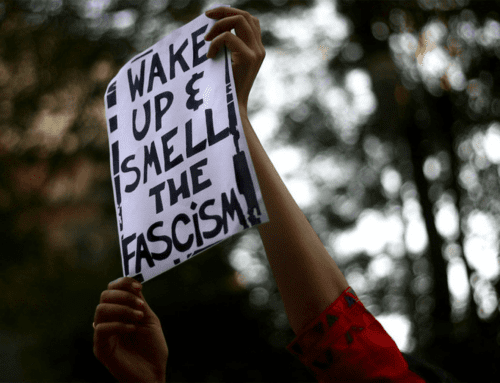

Making Campuses Platforms for Labor Renewal
Everywhere you look this spring, you’ll find evidence that campuses are becoming sites of labor organizing and struggle. In recent months, faculty at the University of Illinois at Chicago staged recently a successful week-long strike, adjunct faculty at the New School won a three-week strike, 50,000 graduate assistants staged a six-week strike across the entire University of California system, staff at American University struck, and undergraduate workers at a growing number of campuses have begun organizing unions and, in some places, even preparing to strike. And this is just a small sampling of what has been afoot.
Now, just as the labor question is bubbling to the surface on campuses across the country, a movement is emerging to connect that energy across multiple campuses: Labor Spring. At this writing more than 60 campuses in 30 states and the District of Columbia are hosting teach-ins and related educational and organizing events under this banner. On February 28, the AAUP chapter at Rutgers University held a rally that included Chris Smalls of the Amazon Labor Union; Sara Nelson, of the Association of Flight Attendants; and Rutgers faculty, graduate assistants, and students, educating the campus in advance of a strike vote for the AAUP chapter, whose members have been working without a contract for over a year. On March 1, Georgetown University students held a teach-in on the conditions face by food service and maintenance workers there. On March 3, the non-tenure track professors of Howard University joined with their allies to host a panel featuring long-time race and economic justice advocate Bill Fletcher, Jr. The Duke Graduate Student Union was featured in an event at Duke University Law School on March 7.
Similar events will unfold non-stop in coming weeks. United Students Against Sweatshops will lead a teach-in at the University of Maryland on March 14 in which students will engage in a mock collective bargaining session. Georgetown Law is hosting one on March 20 featuring Starbucks workers and leaders such as Erica Smiley of Jobs with Justice, Sara Steffens of the Communications Workers of America, Elissa McBride of AFSCME, and the general counsel of the National Labor Relations Board, Jennifer Abruzzo. Many other events are still being planned. The Labor Spring website has a complete list of participating campuses and their events.
These events are reviving the teach-in tradition that was forged in the 1960s by civil rights, students’ rights, and anti-war activists. In some ways, the Labor Spring teach-ins can be seen as a reprise of labor teach-ins that were held in 1996, following reformer John Sweeney’s election to the presidency of the AFL-CIO. Sweeney, who won the first contested election in the labor federation’s history, made it a priority to heal the lingering divisions that had developed between unions and student activists in the era of the Vietnam War. In the summer of 1996 Sweeney’s AFL-CIO launched Union Summer, an effort patterned after the rights movement’s 1964 Freedom Summer, appealing to young people to get a taste of labor organizing. That fall, a series of labor teach-ins were held at Columbia University, the University of Virginia, and eight other campuses that built on Union Summer’s appeal. The New York Times likened the Columbia teach-in to a rock concert. As Steve Fraser and Josh Freeman, two of the organizers of that Columbia event, recently recalled, those teach-ins helped overcome the by then decades long estrangement that had developed between organized labor and the left.
The 1996 labor teach-ins planted important seeds. They led to the formation of Scholars, Artists and Writers for Worker Justice (SAWSJ), which in turn helped create the Labor and Working Class History Association (LAWCHA) in 1998. The teach-ins also helped propel organizing efforts by graduate assistants in the University of California system, paving the way for a system-wide strike in December 1998 which led to the union’s successful election of graduate assistants at UCLA, Berkeley, and six other UC campuses in 1999. It also contributed to the formation of United Students Against Sweatshops (USAS), the Worker Rights Consortium, and even the 1999 Battle of Seattle, that brought together the “Teamsters and turtles” alliance of labor, environmentalist, and anti-corporate-globalization movement against the World Trade Organization.
Unfortunately, the labor revival that began to coalesce at that time was short-lived. The Supreme Court’s December 12, 2000, decision handing the presidency to Republican George W. Bush followed nine months later by the terrorist attacks of September 11, 2001, threw these nascent efforts into disarray. The crash of 2008, the Great Recession, and most recently, the COVID pandemic made it difficult for the movement to recapture the energy that has been coalescing among labor and young people in the late 1990s.
Now, however, abundant evidence suggests that the obstacles that had delayed a resurgence of campus-based labor activism are giving way. Just how much present conditions favor the revival of campus-based labor activism is demonstrated by the breadth of support for Labor Spring.
While the 1996 labor teach-ins focused on a small group of mostly elite campuses, the teach-ins taking place this spring are happening on a broad cross-section of campuses across the nation. Geographically, Labor Spring will take place on dozens of public and private campuses from Massachusetts to Hawaii. Teach-ins will occur in states of varying political character, from the union-dense blue states like New York and California to anti-union red state bastions such as Idaho and Alabama. Public institutions both large and small, from the University of Michiganto New York’s Dutchess Community College, will host events. So will small liberal arts schools like the College of the Holy Cross and HBCUs like Tuskegee University. A range of law schools — including the City University of New York, Harvard, Yale, and Stanford—will host events. So will Vanderbilt Divinity School and the School of the Art Institute of Chicago.
That such widespread interest in labor is coming to such a broad spectrum of campuses at precisely the moment when so many who work on campuses—including undergraduates— are beginning to identify as workers and recognize the value of organizing is a potentially momentous development. Higher education constitutes one of the “commanding heights” of our present day economy. In many places campuses serve as “anchor institutions” in their communities: their practices broadly influence local labor markets for good or ill. They can act as engines of economic development, job creation, social mobility, and inclusivity. Yet they can also exacerbate the worst tendencies of 21st century capitalism: they saddle students with ballooning debt, they contract out an increasing number of services to lower-waged workers, they rely increasingly on the precarious labor of adjunct instructors, and they are too often ruled by boards of trustees and regents who have benefitted the most from the trends of financialization, tax evasion by the wealthy, and surging inequality that are weakening higher education overall.
If Labor Spring can coalesce and magnify the interest in labor organization that we’ve been witnessing both on and adjacent to campuses over recent months, then we are bound to see an exciting year of organizing ahead.
Originally posted by Working-Class Perspectives.







